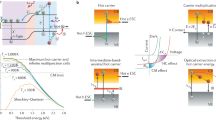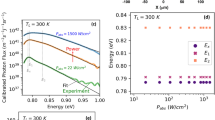Abstract
Hot carrier solar cells offer the potential to exceed the Shockley–Queisser limit. So far, however, there has been no clear route to achieve this result. Recently, the exploitation of the satellite valleys of the solar absorber material has been proposed as a feasible approach to harness hot carriers. Here, we show that, upon photoinduced and field-aided intervalley scattering to upper L-valleys, hot carriers can be harnessed in InGaAs/AlInAs heterojunctions at voltages defined by the upper valley (~1.25 V in the ideal case) rather than the bandgap of the InGaAs absorber (0.75 eV) under practical operational conditions. The efficiency of the present system does not exceed the single bandgap limit due to a mismatch in the valley degeneracy across the n+-AlInAs/n-InGaAs interface. However, we suggest that this is not a fundamental limitation to the realization of a hot carrier solar cell.
This is a preview of subscription content, access via your institution
Access options
Access Nature and 54 other Nature Portfolio journals
Get Nature+, our best-value online-access subscription
$29.99 / 30 days
cancel any time
Subscribe to this journal
Receive 12 digital issues and online access to articles
$119.00 per year
only $9.92 per issue
Buy this article
- Purchase on Springer Link
- Instant access to full article PDF
Prices may be subject to local taxes which are calculated during checkout





Similar content being viewed by others
Data availability
All the data generated or analysed during this study are included in this published article and its Supplementary Information files. The data that support the plots within this paper are available from the corresponding authors upon reasonable request.
Change history
29 July 2020
A Correction to this paper has been published: https://doi.org/10.1038/s41560-020-00679-4
References
Ross, R. T. & Nozik, A. J. Efficiency of hot-carrier solar energy converters. J. Appl. Phys. 53, 3813–3818 (1982).
Shockley, W. & Queisser, H. J. Detailed balance limit of efficiency of p-n junction solar cells. J. Appl. Phys. 32, 510–519 (1961).
Dimmock, J. A. R., Day, S., Smith, K., Kauer, M. & Heffernan, J. Demonstration of a hot-carrier photovoltaic cell. Prog. Photovolt. 22, 151–160 (2014).
Nguyen, D.-T. et al. Quantitative experimental assessment of hot carrier-enhanced solar cells at room temperature. Nat. Energy 3, 236–241 (2018).
Hirst, L. C., Walters, R. J., Fuhrer, M. F. & Ekins-Daukes, N. J. Experimental demonstration of hot-carrier photocurrent in an InGaAs quantum well solar cell. Appl. Phys. Lett. 104, 231115 (2014).
Rodière, J. et al. Experimental evidence of hot carriers solar cell operation in multi-quantum wells heterostructures. Appl. Phys. Lett. 106, 183901 (2015).
Yao, Y. & König, D. Comparison of bulk material candidates for hot carrier absorber. Sol. Energy Mater. Sol. Cells 140, 422–427 (2015).
Conibeer, C. J. et al. Slowing of carrier cooling in hot carrier solar cells. Thin Solid Films 516, 6948–6953 (2008).
Gibelli, F., Lombez, L. & Guillemoles, J.-F. Accurate radiation temperature and chemical potential from quantitative photoluminescence analysis of hot carrier populations. J. Phys. Condens. Matter 29, 06LT02 (2016).
Ryan, J. F. et al. Time-resolved photoluminescence of two-dimensional hot carriers in GaAs-AlGaAs heterostructures. Phys. Rev. Lett. 53, 1841–1844 (1984).
Le Bris, A. et al. Thermalisation rate study of GaSb-based heterostructures by continuous wave photoluminescence and their potential as hot carrier solar cell absorbers. Energy Environ. Sci. 5, 6225–6232 (2012).
Hirst, L. C. et al. Hot carriers in quantum wells for photovoltaic efficiency enhancement. IEEE J. Photovolt. 4, 244–252 (2014).
Hirst, L. C. et al. Enhanced hot-carrier effects in InAlAs/InGaAs quantum wells. IEEE J. Photovolt. 4, 1526–1531 (2014).
Ferry, D. K. In search of a true hot carrier solar cell. Semicond. Sci. Technol. 34, 044001 (2019).
Whiteside, V. R. et al. The role of intervalley scattering in hot carrier transfer and extraction in type-II InAs/AlAsSb quantum well solar cells. Semicond. Sci. Technol. 34, 094001 (2019).
Clady, R. et al. Interplay between the hot phonon effect and intervalley scattering on the cooling rate of hot carriers in GaAs and InP. Prog. Photovolt. 20, 82–92 (2012).
Grann, E. D., Tsen, K. T. & Ferry, D. K. Non-equilibrium phonon dynamics and electron distribution functions in InP and InAs. Phys. Rev. B 53, 9847–9851 (1996).
Lugli, P. Non-equilibrium longitudinal-optical phonon effects in GaAs-AlGaAs quantum wells. Phys. Rev. Lett. 59, 716–719 (1987).
Prabhu, S. S., Vengurlekar, A. S., Roy, S. K. & Shah, J. Non-equilibrium dynamics of hot carrier and hot phonons in CdSe and GaAs. Phys. Rev. B 51, 14233–14246 (1995).
Gunn, J. B. Microwave oscillations of current in III-V semiconductors. Solid State Commun. 1, 88–91 (1963).
Ridley, B. K. & Watkins, T. B. The possibility of negative resistance effects in semiconductors. Proc. Phys. Soc. 78, 293–304 (1961).
Ayubi-Moak, J. S. et al. Simulation of ultra-sub-micron-gate In0.52Al0.48As/In0.75Ga0.25As/In0.52Al0.48As pseudomorphic HEMTs using a full-band Monte Carlo simulator. IEEE Trans. Electron Devices 54, 2327–2338 (2007).
Akis, R. et al. Full-band cellular Monte Carlo simulations of terahertz high electron mobility transistors. J. Phys. Condens. Matter 20, 384201 (2008).
Rosenwaks, Y. et al. Hot-carrier cooling in GaAs: quantum wells versus bulk. Phys. Rev. B. 48, 14675–14678 (1993).
Wurfel, P. The chemical potential of radiation. J. Phys. Chem. C 15, 3967–3985 (1982).
Murdin, B. N. et al. Direct observation of the LO phonon bottleneck in wide GaAs/AlxGa1−xAs quantum wells. Phys. Rev. B 55, 5171–5176 (1997).
Conibeer., G. J. et al. Progress on hot carrier cells. Sol. Energy Mater. Sol. Cells 93, 713–719 (2009).
Conibeer, G. J. et al. Modelling of hot carrier solar cell absorbers. Sol. Energy Mater. Sol. Cells 94, 1516–1521 (2010).
Welland, I. & Ferry, D. K. Electron transport in the solar-relevant InAlAs. Semicond. Sci. Technol. 34, 064003 (2019).
Esmaielpour, H. et al. Effect of occupation of the excited states and phonon broadening on the determination of the hot carrier temperature from CW photoluminescence in InGaAsP quantum well absorbers. Prog. Photovolt. 25, 782–790 (2017).
Ferry, D. K. Semiconductors Sec. 10.4, 11.4.4 (Macmillan, 1991).
Acknowledgements
The authors acknowledge financial support from the National Science Foundation ECCS program through grant no. ECCS-1610062. This work was performed under the umbrella of the Oklahoma Photovoltaics Research Institute (OKPVRI) and the Center for Quantum Research and Technology (CQRT) at the University of Oklahoma.
Author information
Authors and Affiliations
Contributions
The devices were processed by H.E. and K.R.D. The data were taken and analysed by a combination of H.E., K.R.D. and V.R.W. at OU. Theoretical calculations were performed by D.K.F. at ASU. The materials were grown by molecular beam epitaxy at OU by T.D.M. under the supervision of M.B.S. All experimental work was performed in the group of I.R.S., whom also provided scientific and technical guidance, as well as project management. The manuscript was written by a combination of V.R.W., I.R.S. and D.K.F.
Corresponding author
Ethics declarations
Competing interests
The authors declare no competing interests
Additional information
Publisher’s note Springer Nature remains neutral with regard to jurisdictional claims in published maps and institutional affiliations.
Supplementary information
Supplementary Information
Supplementary Figs. 1−6, discussion and refs. 1–2.
Rights and permissions
About this article
Cite this article
Esmaielpour, H., Dorman, K.R., Ferry, D.K. et al. Exploiting intervalley scattering to harness hot carriers in III–V solar cells. Nat Energy 5, 336–343 (2020). https://doi.org/10.1038/s41560-020-0602-0
Received:
Accepted:
Published:
Issue Date:
DOI: https://doi.org/10.1038/s41560-020-0602-0
This article is cited by
-
The role of nonequilibrium LO phonons, Pauli exclusion, and intervalley pathways on the relaxation of hot carriers in InGaAs/InGaAsP multi-quantum-wells
Scientific Reports (2023)
-
Hot-carrier dynamics in InAs/AlAsSb multiple-quantum wells
Scientific Reports (2021)
-
Hot carrier photovoltaics in van der Waals heterostructures
Nature Reviews Physics (2021)
-
Quasiadiabatic electron transport in room temperature nanoelectronic devices induced by hot-phonon bottleneck
Nature Communications (2021)
-
Get them while they’re hot
Nature Energy (2020)



